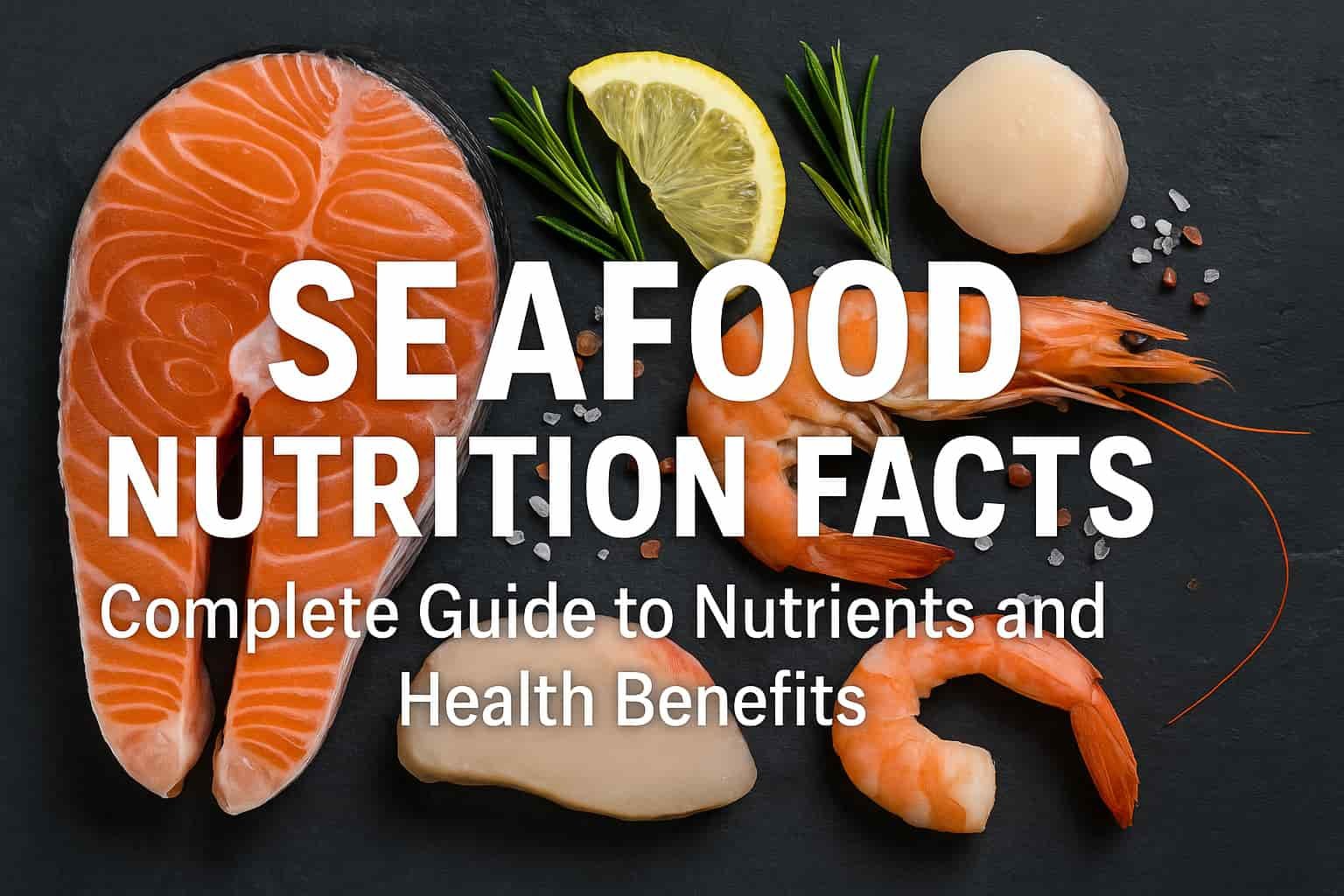Seafood is a rich source of high-quality nutrients that directly support heart health, brain function, and metabolic balance. Unlike many other protein sources, seafood offers essential omega-3 fatty acids, complete proteins, and critical vitamins such as D and B12 in highly bioavailable forms. According to the USDA, consuming at least 227 grams (8 ounces) of seafood weekly is associated with significant health benefits, including reduced cardiovascular disease risk by up to 36%. This guide provides verified nutritional facts across various seafood types, allowing you to choose the best options based on your specific health goals.
Contents
- 1 What Are the Key Nutrients Found in Different Types of Seafood?
- 2 How Do Omega-3 Fatty Acids in Seafood Benefit Your Health?
- 3 Does Eating Seafood Help Improve Brain Function and Cognitive Health?
- 4 How Does Seafood Support Weight Management and Metabolism?
- 5 What Are the Vitamin and Mineral Profiles of Common Seafood?
- 6 Are There Health Risks Associated with Seafood Consumption?
- 7 How to Choose the Healthiest Seafood Based on Nutritional Content?
- 8 How Do Cooking Methods Affect the Nutritional Value of Seafood?
- 9 How Often Should You Include Seafood in Your Weekly Diet for Optimal Health?
- 10 What Are the Recommended Seafood Portion Sizes for Children and Adults?
What Are the Key Nutrients Found in Different Types of Seafood?
Seafood provides complete proteins, essential fatty acids, and key micronutrients including iodine, selenium, and vitamin D. These nutrients play vital roles in maintaining heart health, supporting cognitive function, and boosting immune defenses.
- Proteins: Found abundantly in fish like salmon and tuna, offering 20–25 grams per 100 grams serving.
- Omega-3 Fatty Acids: Present in high amounts in fatty fish such as mackerel and sardines, providing up to 2.2 grams of EPA and DHA per 100 grams.
- Vitamins: Seafood is one of the few natural sources of vitamin D, with salmon containing up to 526 IU per 100 grams, meeting 66% of the daily recommended intake.
- Minerals: Shellfish like oysters and mussels deliver high levels of zinc, iron, and selenium, essential for immune function and antioxidant protection.
How Do Omega-3 Fatty Acids in Seafood Benefit Your Health?
Omega-3 fatty acids in seafood improve cardiovascular health, reduce chronic inflammation, and support cognitive performance.
- Cardiovascular Benefits: Clinical studies show that consuming at least 250–500 mg of EPA and DHA daily can lower triglyceride levels by 15–30% and reduce heart disease risk.
- Anti-Inflammatory Effects: Omega-3s decrease inflammatory markers such as C-reactive protein (CRP), directly benefiting individuals with rheumatoid arthritis and other inflammatory conditions.
- Cognitive Support: Regular seafood intake is linked to a 24% lower risk of cognitive decline in older adults, according to research published in JAMA Neurology.
Does Eating Seafood Help Improve Brain Function and Cognitive Health?
Eating seafood improves brain health by providing DHA, a critical structural component of the brain’s gray matter.
- Scientific Evidence: A longitudinal study involving over 15,000 participants found that higher seafood consumption correlates with improved memory retention and slower cognitive decline.
- Pregnancy and Fetal Brain Development: Consuming at least 200 mg of DHA daily during pregnancy supports optimal fetal brain and visual development. Health organizations, including the American Pregnancy Association, recommend incorporating fatty fish like salmon and sardines into maternal diets.
How Does Seafood Support Weight Management and Metabolism?
Seafood supports weight management by providing high-quality protein with low calorie content, promoting satiety and increasing metabolic rate.
- High-Protein, Low-Calorie Options:
- Shrimp provides 24 grams of protein with only 99 calories per 100 grams.
- Cod offers 20 grams of protein and just 82 calories per 100 grams.
- Thermic Effect of Protein: Digesting protein from seafood increases the thermic effect of food (TEF) by 15–30%.
- Satiety and Appetite Control: Clinical trials show that individuals who consume seafood-based meals experience 22% greater satiety and reduced calorie intake in subsequent meals compared to those consuming other protein sources.
What Are the Vitamin and Mineral Profiles of Common Seafood?
Seafood delivers a concentrated source of essential vitamins and minerals required for optimal body function.
- Vitamin D:
- Salmon contains up to 526 IU of vitamin D per 100 grams, covering 66% of the daily value (DV).
- Mackerel provides 360 IU per 100 grams, fulfilling 45% of DV.
- Zinc and Iron in Shellfish:
- Oysters offer 39.3 mg of zinc per 100 grams, which is 357% of the DV.
- Clams provide 28 mg of iron per 100 grams, fulfilling 155% of the DV.
- Iodine for Thyroid Health:
- Seaweed and cod are excellent iodine sources, with cod containing 99 mcg per 100 grams, accounting for 66% of the recommended intake.
Are There Health Risks Associated with Seafood Consumption?
Seafood consumption can pose health risks related to mercury contamination, heavy metal exposure, and microbial hazards if consumed raw or improperly cooked.
- Mercury Levels in Popular Seafood Types:
- High-mercury fish include shark, swordfish, and king mackerel, containing up to 0.99 ppm of mercury.
- Low-mercury options like salmon, shrimp, and scallops contain less than 0.09 ppm.
- Reducing Heavy Metal Exposure:
- Prioritize smaller, short-lived fish like sardines and anchovies.
- Choose certified sustainable seafood verified by organizations such as MSC (Marine Stewardship Council).
- Raw Seafood Safety Concerns:
- Raw or undercooked seafood may carry pathogens including Vibrio, Salmonella, and Norovirus.
- Purchase sushi-grade seafood and ensure proper storage at below 4°C (39.2°F).
How to Choose the Healthiest Seafood Based on Nutritional Content?
To choose the healthiest seafood, prioritize species with high omega-3 content, low mercury levels, and rich vitamin and mineral profiles.
- Wild-Caught vs. Farm-Raised:
- Wild-caught salmon contains up to 2.6 grams of omega-3 per 100 grams, while farm-raised offers 1.8 grams.
- Wild species generally have fewer contaminants but lower fat content.
- Focus on Nutrient-Dense Species:
- Sardines, mackerel, and herring are rich in omega-3, calcium, and vitamin D.
- Shellfish like oysters and clams provide high levels of zinc, iron, and selenium.
- Avoid High-Mercury Fish:
- Limit species such as tilefish, shark, and swordfish to reduce mercury exposure.
How Do Cooking Methods Affect the Nutritional Value of Seafood?
Cooking methods significantly impact the retention of nutrients, particularly omega-3 fatty acids and heat-sensitive vitamins.
- Best Methods for Nutrient Preservation:
- Steaming and baking retain over 90% of omega-3 content.
- Grilling maintains flavor but may lead to 10–15% loss of vitamin D.
- Methods That Reduce Nutritional Value:
- Deep-frying increases calorie content by up to 200% and destroys heat-sensitive nutrients.
- Boiling leads to the leaching of minerals, reducing content by up to 25%.
- Recommendation:
- Prefer steaming, baking, or poaching, and avoid overcooking to preserve nutrients.
How Often Should You Include Seafood in Your Weekly Diet for Optimal Health?
You should include seafood in your diet at least twice per week, totaling 227–340 grams (8–12 ounces), to meet recommended omega-3 intake and support long-term health.
- General Population Guidelines:
- The American Heart Association recommends at least two servings of fatty fish per week to reduce cardiovascular disease risk by up to 36%.
- Special Considerations for Pregnant Women and Children:
- Pregnant women should consume two to three servings of low-mercury seafood per week.
- For children:
- Ages 2–4: 28–56 grams (1–2 ounces) per week.
- Ages 5–8: 56–85 grams (2–3 ounces) per week.
What Are the Recommended Seafood Portion Sizes for Children and Adults?
The recommended seafood portion sizes vary by age group to optimize nutrient intake while minimizing exposure to contaminants.
- For Adults:
- Healthy adults should consume 227–340 grams (8–12 ounces) of a variety of seafood weekly.
- Individuals with heart disease should increase intake to at least 340 grams (12 ounces) per week, following AHA guidelines.
- For Pregnant and Breastfeeding Women:
- Recommended intake is 226–340 grams (8–12 ounces) per week of low-mercury seafood such as salmon, sardines, and shrimp.
- High-mercury fish like king mackerel and shark should be completely avoided.
- For Children (FDA Guidelines):
- Ages 1–3: 28–56 grams (1–2 ounces) per week.
- Ages 4–7: 56–85 grams (2–3 ounces) per week.
- Ages 8–12: 85–170 grams (3–6 ounces) per week.
To ensure safety when including seafood in children’s diets, refer to our guide on Is Raw Seafood Safe to Eat?, which explains how to select low-risk seafood options and proper preparation methods for young consumers.



